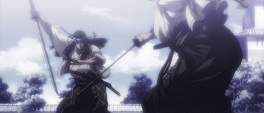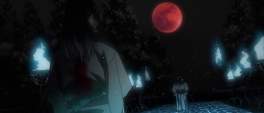First released: July 2007
The opening moments of Shiguri are divisive: after a montage of lingering, abstract motions, a retainer prostrates himself before his lord and, in slick, gory detail, fatally offers his intestines up to enforce the severity of his request. What follows in the succeeding episodes is often harrowing, frequently disgusting, but never gratuitous - a meditation on the consequences of violence, set within a fiercely feudal system where the sword is the highest form of law. Coming from the same director as the exquisite Texhnolyze and the same studio as Aoi Bungaku, the subdued and graceful viciousness of the story is accompanied by visuals that are as dark as they are breathtaking. The whole then is a deeply affecting series that challenges many tropes common to the samurai genre and proves there is still a place for a poised and measured storytelling style.
When a local lord calls a tournament, two visibly deformed swordsmen enter the arena: one missing his left arm, the other is blind and limping. The pair share a chequered history as two of the last practitioners of the Kogan style of swordplay. Named after Kogan Iwamoto, who after a faux pas concerning his polydactylism cost him a high ranking position, set up the school. Seigen Irako joined when Gennosuke Fujiki was still an assistant instructor, and after only a year came to rival him in proficiency. Both men vie for the position of successor to the Kogan style, and for the affections of Kogan's daughter, Mie; Seigen's hubris however will be his undoing as the school is unforgiving of slights against them and the punishment meted out will surpass mere cruelty. Revenge however, is just as ruthless.
Suppressing the urge to indulge in a swords-and-honour tale, the series revels in the stand-off; those pregnant moments prior to battle when each combatant stands coiled and ready before the onslaught. It is those silent reposes that characterise the fights, the clash of swords itself is swift, brutal and deadly but much is made of aftermath. Whether that is picking the shattered teeth from the victor's hands or dealing with the remains of the loser, there is no shying away from and, crucially, no glorification of this violence. All of the participants are shown as stoic and unfeeling - the rare grimace is a thing to fear - for this is their life and their choice, not a burden placed upon them or a journey to survive. There is no mention of a code, their honour is not a concept to turn them into a chivalrous white-knight but presented as a way for them to advance within the prevailing power structure. It's an odd and ephemeral concept that is often hinted at in other series that typify the genre, but here it underpins the entire narrative.
It is the antithesis of the comparably fluffy samurai films; even keystones of the genre such as those by Kurosawa - which are filled with thieves and duplicity - are starkly tame set against this bleak and disturbing view of humanity. The brutality, both physical and mental is unrelenting with madness, dementia, catatonia, gore and a fascination with disfigurement all featuring heavily. There is no humour or light relief here, from start to finish the series is awash with blood and does not skimp on graphic depictions of sexual acts or bodily secretions with some sequences excruciating to watch - the result feels very raw and primal, as far from top-knots and toffs as possible. It taps into emotions many series would dare not to invoke and, combined with a sparseness of dialogue, the potency of the story and the pathos it invokes are unmatched. It's easy to see where the proficiency shown in Aoi Bungaku stemmed from.
Similarly so for the visuals which share Texhnolyze's washed out, high-contrast style that makes daylight harsh and shadows undulate with detail. The opening episodes favour monochrome shots of the fighters, their musculature in sharp relief as anatomical flashes show the tendons and sinew beneath the skin. These wane towards the middle of the series when a more dreamlike tone is set with fleeting images flickering into life then disappearing; whereas the climactic episodes expertly use analogies with people and situations taking on their mythical personas with fearsome ease. Statically the visuals are unparalleled, rife with detail and brilliantly colour graded to maintain the series' oppressive tone. The animation however, while stunning, is restrained by the direction of the series which favours lingering close-ups rather than fluid high motion. Regardless, there is no dip in quality or shortcuts taken and the constant fidelity means the series is abjectly beautiful.
Shigurui is the converse of universally accessible - the style could equally be viewed as ponderous and pretentious rather than poignant and poised; the gore indulgent and played for shocks rather than shocking and gruesome. The series makes no motions towards approachability, for the story it tells and the message it peddles are divisive and remorseless. The near nihilistic outlook makes it difficult to be entirely comfortable but tricky not to be enthralled by the voyeurism of peering into a vicious and horrific world. One whose historical accuracy may be suspect but which retains enough authenticity to make the fantastic more digestible. Bold, arresting and brilliant, some may find it hard to tolerate, for others it is a trip into the sublime.











